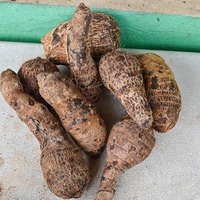Common name: Cocoyam
Other common names: Chinese taro, Coco, Eddoe, Tannia
Description
Cocoyam is a fast-growing, perennial herb native to tropical America, its natural range extending from the Caribbean to northern parts of South America, where it has long been cultivated for its potato-like cormels, these being cooked and eaten as a starchy vegetable.
The leaves are eye-catching, dark green with a very large heart shape, some up to 1 m (3 ft) long and nearly as wide. They sit atop pale green succulent stems growing up from a central tuber, which develops underground.
The stems, which may be 1 to 2 m (3 to 6 ft) tall, are thick at the base then taper toward the leaf end. They lean away from the centre of the plant, bent outward by the weight of the leaf. Because of their large size, the leaves are either touching or overlapping, forming a dense, umbrella-like canopy.
The flowers are borne on an erect, finger-like spike partly enclosed by a large, semi-circular, cream-coloured bract or spathe and sit on top of a short flower stalk at the centre of the plant, just beneath the leaves.
Flowers are either female or male, borne separately on different spike parts, with the female flowers closer to the base. Though they become pollinated, they rarely produce seed.
Edible cormels are around the size of a large potato. Elongated at one end, they develop attached to the outside of the central tuber. They have thick, rough brown skin with white flesh underneath, less commonly yellow or pink depending on the variety.
Use
When peeled, the cormels can be prepared similarly to potatoes, roasted, boiled or steamed on their own, cooked in soups or stews, mashed or pureed, or sliced and fried to make chips, crisps or fritters. The flavour is starchy like a potato, earthy and slightly nutty.
The cormels can also be ground and dried to make flour or grated to make a starch used as a thickening agent. Only the cormels are eaten, not the central tuber, which is unfit for human consumption. The leftover central tuber is sometimes cut into pieces, boiled and fed to pigs.
The small young leaves are also edible and can be cooked and served as a leafy vegetable, similar to spinach. Cattle, sheep and goats forage the leaves, which have a reported crude protein content of 22% of their dry weight.
It is occasionally cultivated as an ornamental for its massive leaves, which add a lush tropical look to gardens.
Climate
It grows naturally and is productive in humid subtropical and tropical lowland climates, generally areas with annual lows of 13 to 25°C, annual highs of 24 to 35°C, annual rainfall of 1200 and 6000 mm and a dry season of 4 months or less.
Growing
New plants are grown either from surplus cormels, sections of the central tuber, or stems with a piece of central tuber intact. Overall, growth rates and cormel yields are best when sections of the central tuber are used for planting.
It performs best on free-draining, rich loam soils with a slightly acid to neutral pH, generally in the range of 5.5 to 7.0 and on sites with full sun to light shade exposure. Though known to thrive in moist soils along stream banks, it does not tolerate waterlogging.
The cormels can be harvested after about five months and as needed until the plant starts to die back, usually at around nine to ten months and indicated by the older leaves turning yellow. Care is taken when unearthing the cormels not to cut or bruise them as this will shorten their shelf-life, which is usually around three months when stored in a cool, dry place.
Average yields of 1 to 2 kg (2 to 4 lbs) per plant can be expected or between 10,000 and 20,000 kg per hectare (4.5 to 9 tons per acre) per year in intensive farming systems and with yields as high as 30,000 kg per hectare (13 tons per acre) having been reported.
Problem features
Although it rarely sets seed, tuber or cormel pieces left in the grown with grow to form new clumps of plants. It is recorded as having escaped cultivation and as a weed of agriculture, mainly in countries in the Pacific region.
All plant parts, especially the central tuber, contain calcium oxalate, a gastrointestinal irritant if consumed raw or uncooked, mainly causing burning and inflammation to the mouth and throat. The plant sap may also be a skin and eye irritation to some people.
Where it grows
References
Books
-
Adams, C. D. 1972, Flowering plants of Jamaica, University of the West Indies, Mona, Greater Kingston
-
Elevitch, C. R. & Thaman, R. R. 2011, Specialty crops for Pacific islands, 1st ed, Permanent Agriculture Resources, Hawaii
-
Gohl, B. 1981, Tropical Feeds : feed information summaries and nutritive values (Revised edition), Food and Agriculture Organization of the United Nations (FAO), Rome
-
Hanson, B. 2007, Buried treasures : tasty tubers of the world : how to grown and enjoy root vegetables, tubers, rhizomes, and corms, Brooklyn Botanic Garden, Brooklyn, New York
-
Higman, B. W 2008, Jamaican food : history, biology, culture, University of the West Indies Press, Kingston, Jamaica
-
Horton, D. 1988. Underground crops: long-term trends in production of roots and tubers. Winrock International, USA.
-
Leon, J & Hernandez Bermejo, J. Esteban & Programma Ethnobotanica 92. 1994, Neglected crops : 1492 from a different perspective, Food and Agriculture Organization of the United Nations, Rome
-
Litzenberger, S. C. 1974, Guide for field crops in the tropics and the subtropics, Office of Agriculture, Technical Assistance Bureau, Agency for International Development (USAID), Washington D.C.
-
Morgan, D. & Achilleos, A. 2012, Roots : the definitive compendium with more than 225 recipes, Chronicle Books, San Francisco
-
National Research Council (Board on Science and Technology for International Development) 1975, Underexploited tropical plants with promising economic value, National Academic Press, Washington D. C.
-
Nelson, L. & Shih, R. & Balick, M. J., 2007, Handbook of poisonous and injurious plants, 2nd ed, New York Botanical Gardens, Springer, New York
-
Perkins, K. D. & Payne, W. 1981, Guide to the poisonous and irritant plants of Florida, Florida Cooperative Extension Service, Gainesville, Florida
-
Purseglove, J. W. 1981, Tropical crops: Monocotyledons, Longman, Harlow, London
-
Randall, R. P. 2002, A global compendium of weeds, R.G. and F.J. Richardson Press, Melbourne
-
Randall, R. P. 2007, The introduced flora of Australia and its weed status, Cooperative Research Centre for Australian Weed Management, Glen Osmond, South Australia
-
Roecklein, J. C & Leung, P.S. 1987, A Profile of economic plants, Transaction Books, New Brunswick, New Jersey





